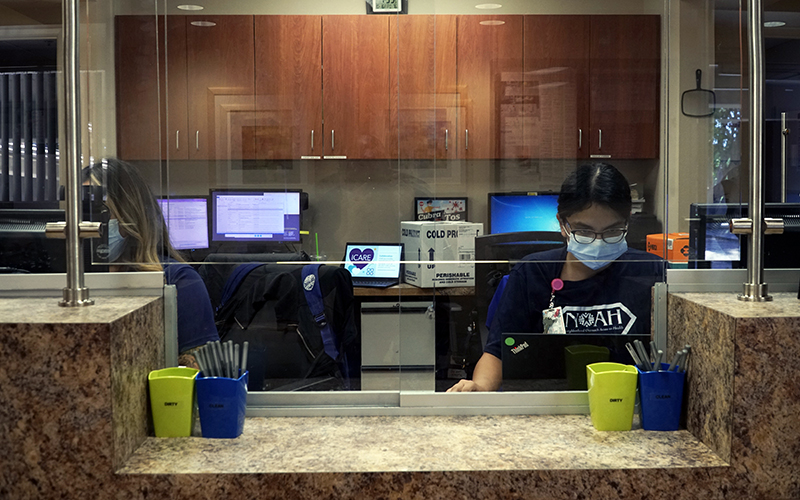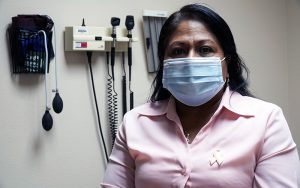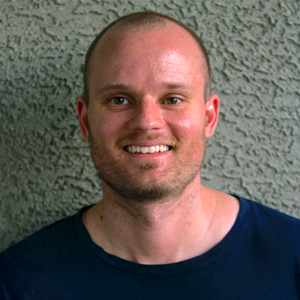
Desert Mission Health Center in Phoenix’s Sunnyslope neighborhood provides medical, dental and behavioral care to patients regardless of their ability to pay. NOAH and other community health clinics have been hit hard by COVID-19. (Photo by Franco LaTona/Cronkite News)

Financial aid from last spring’s federal CARES Act allowed Neighborhood Outreach Access to Health and other community health centers to retain employees amid declining patient visits and other threats to funding streams. (Photo by Franco LaTona/Cronkite News)
PHOENIX – On a sun-drenched afternoon, Ana Brito arrives for a doctor’s appointment at Desert Mission Health Center, greeting staff members in Spanish. Nestled on a quiet street in north central Phoenix, the clinic is a one-stop shop for some of the city’s most vulnerable.
Brito, 46, and her husband are uninsured, but the clinic provides medical and dental care at discounted rates. She doesn’t own a vehicle or drive, but the clinic is close enough that she can walk.
“I like the service,” she said, “and the people and staff are very friendly.”
Desert Mission is one of nine clinics operated by Neighborhood Outreach Access to Health, a federally designated community health center that provides medical, dental and behavioral health care to patients mostly from marginalized communities, regardless of their ability to pay.
Clinics like these are a vital part of the nation’s health care system. Begun in 1965 amid the federal government’s “war on poverty,” community health clinics provide care for more than 29 million people in medically underserved communities.
By the beginning of this year, about 1,400 community health centers operated more than 14,000 service locations in all 50 states, with 68% of patients falling below the federal poverty line of $26,200 for a family of four.
Then came COVID-19. Now, amid declining patient visits and other threats to funding streams, community health centers across the country are struggling to stay open.
In May, four months after the novel coronavirus outbreak started in Wuhan, China, 1,954 community health center sites had temporarily closed, the Kaiser Family Foundation reported. Although the numbers have improved, at least 564 sites were closed as of Oct. 30, statistics show.

Ana Brito, 46, is a patient of Desert Mission Health Center. Brito and her husband are uninsured, but the clinic provides medical and dental care at discounted rates. (Photo by Franco LaTona/Cronkite News)
The financial hit is estimated to be at least $2.9 billion nationwide, according to a study from the Milken Institute School of Public Health at George Washington University.
In addition to providing standard health services, these clinics have been on the front lines of COVID-19 testing efforts in underserved urban and rural communities.
In Arizona, 23 community health centers operate 176 sites throughout the state. Tara McCollum of the Arizona Alliance for Community Health Centers said most centers in Arizona experienced drops of 35% to 80% for in-person patient visits.
“Even the sliding fee scale wasn’t enough to bring people in,” she said, referring to discounts offered to uninsured patients. With the sliding scale, the less money a patient earns, the lower the cost.
Such discounts are made possible with financial assistance from the Community Health Center Fund, a federal program created through the Affordable Care Act of 2010. Congress renewed funding for the program last year at $5.6 billion, but that money is set to expire later this year.
With the ACA now under review by the U.S. Supreme Court, advocates worry the health center fund could be wiped out if the court decides to repeal the Affordable Care Act.
The money from that fund, along with visits from privately insured patients and patients on Medicaid, allow community health centers to provide care for low-income people who are uninsured.
Wendy Armendariz, chief executive officer of Neighborhood Outreach Access to Health, or NOAH, said about 20% of her organization’s patients are uninsured.
“Whatever the situation is, we want to serve them regardless of their ability to pay,” she said.
In 2019, NOAH served over 35,000 patients across its nine clinics. When COVID-19 struck, Desert Mission and two other clinics ceased all in-person visits, and dental appointments were canceled at all locations, except for one providing emergency services.
“That severely impacted our revenue,” Armendariz said.
Because it employs fewer than 500 people, NOAH obtained funds from the coronavirus aid package Congress passed this spring, which helped it avoid layoffs. The group also moved quickly to telehealth visits, and Armendariz expects that to continue beyond the pandemic.
All centers recently started in-person visits again, including dental, except for one site that provides behavioral health services only. Armendariz estimated that patient visits are 70% to 80% of pre-COVID levels.
The reopening is good news for 16-year-old Monica Ceron of Phoenix, who has been getting her teeth checked at Desert Mission since she was a child.
“When COVID started, I didn’t consider moving to a different dental place. I was willing to wait,” she said after a recent visit. “I trust them basically.”
Community health center patients are disproportionately people of color. Hispanics comprise about 18% of the U.S. population but 38% of community health center patients. African Americans comprise about 12% of the population but 19% of health center patients.
Armendariz said the racial makeup of NOAH’s patients varies by location, but Hispanics account for about 50% of the total.
Rosa Felix, a sophomore at Arizona State University who grew up in west Phoenix, recently obtained insurance through Arizona’s Medicaid program after leaving her family’s health care plan. She goes to Desert Mission for medical and dental services, as do her mother and younger sister.
“They serve the more underprivileged,” Felix said. “I see more people that I grew up with here.”
Other Desert Mission patients said the clinic means more to them than just a place to go for a quick checkup.
Ceron said she would have to track down “every single staff member” if the center were ever to close for good, adding, “They watched me grow as a person.”
Brito agreed. “I feel like they are part of a family.”
COVID-19 is not the only challenge community health centers are facing. Many receive significant discounts on prescription drugs through a federal program that allows qualified clinics to contract with commercial pharmacies, including Walgreens and CVS.
But some drug manufacturers have said they will either no longer participate in the program or only allow clinics to contract with one pharmacy, which could leave rural patients having to drive hundreds of miles to pick up medication.
Emily Oake, special populations coordinator for the Arizona Alliance for Community Health Centers, said if more drug manufacturers follow that trend, “It would be a devastating thing for all community health centers in Arizona.”


